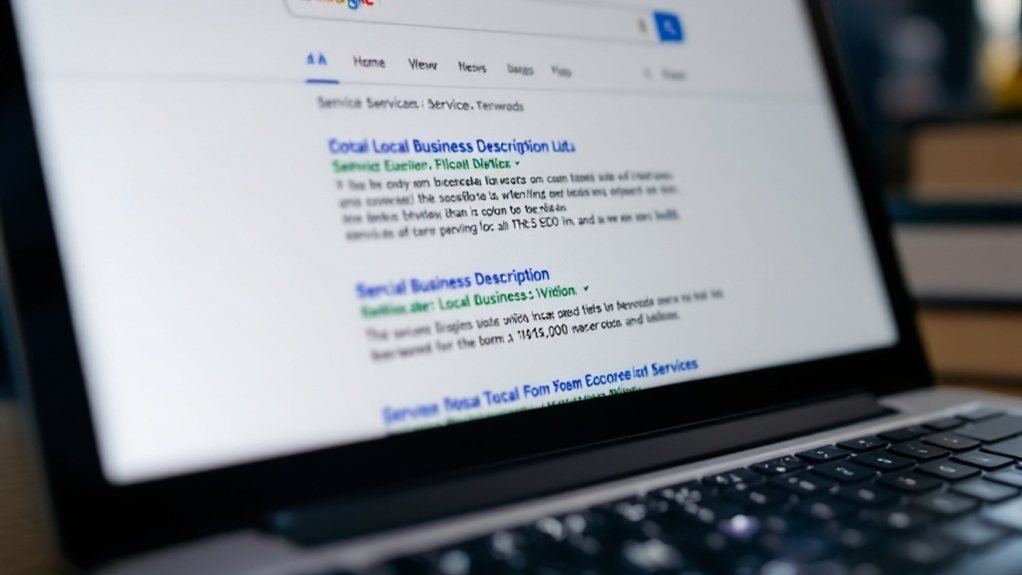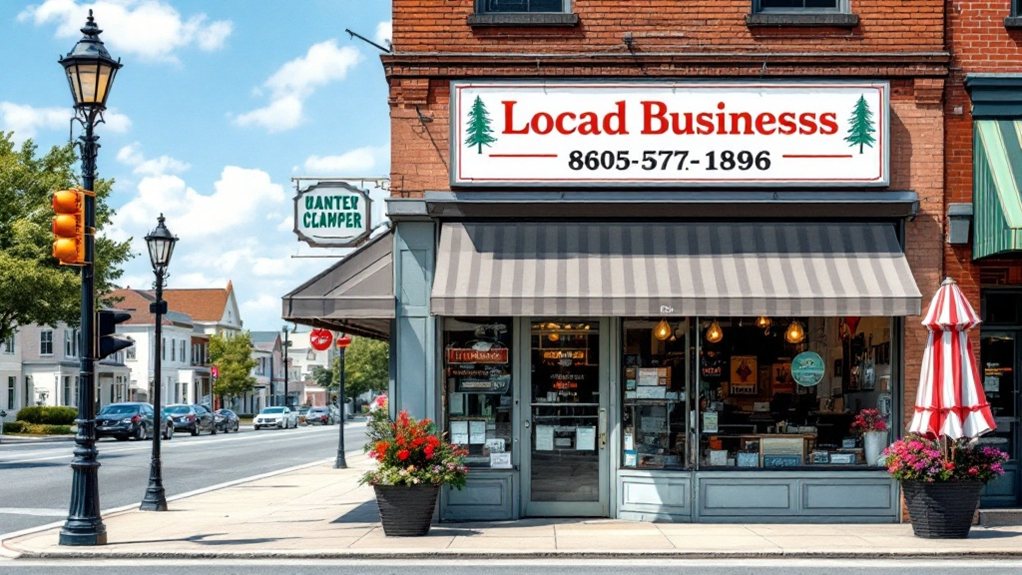To optimize your service descriptions for local SEO, start by identifying relevant keywords using tools like SEMrush's Keyword Magic Tool. Craft compelling, detailed descriptions that emphasize your local expertise, unique selling points, and visual elements. Incorporate location-specific details and schema markup to improve your visibility in local search. Highlight what makes your services unique and address customer needs. By optimizing your service pages, you'll connect with your target audience and enhance your online presence within your local community.
Identify Target Keywords

How do you identify the right target keywords for your local SEO strategy? Start by utilizing tools like SEMrush's Keyword Magic Tool or Google's Keyword Planner to uncover relevant keywords. Begin with general business terms and services, then add location modifiers. Consider keywords with a balance of search volume and feasible ranking difficulty. Analyze your competitors' rankings to discover overlooked keywords. Identify implicit local keywords that trigger the local pack feature on Google. Incorporate geographical qualifiers, hyperlocal focus, and long-tail phrases to specify search intent. Regularly review and update your local keyword strategy to stay ahead of changing trends.
Craft Compelling Service Descriptions

Crafting compelling service descriptions is crucial for capturing the attention of your local audience. Be specific and detailed – include the benefits, specialized equipment, and relevant certifications. Emphasize your local relevance by mentioning area-specific challenges, regulatory know-how, and local testimonials. Consistent business contact information can help establish your business as a local, legitimate operation. Use engaging, customer-centric language to create an emotional connection. Visuals like images and videos can demonstrate your services in action. Encourage interaction with clear calls-to-action, feedback opportunities, and contact details. By following these strategies, you'll create service descriptions that resonate with your local community and drive more business through your doors.
Incorporate Location-Specific Details

When optimizing your local SEO, you'll want to incorporate location-specific details throughout your service descriptions. Use keywords that include city or region names to target local search queries. Ensure your service descriptions contain information relevant to local audiences, and tailor each one to reflect local nuances. Utilize schema markup to include details like address and business hours for better local search visibility. Highlight your involvement in the local community to build relevance. These location-specific elements will help your services stand out and resonate with your target audience. Regularly updating your service descriptions with new location-relevant information can further improve your local SEO performance.
Highlight Unique Selling Propositions
As you optimize your local SEO, don't overlook the power of highlighting your business's unique selling propositions (USPs). A well-crafted USP can set you apart from competitors and attract more customers. To make the most of your USPs, focus on:
- Emphasizing your community involvement or specialized services.
- Tailoring your USPs to address customer needs and pain points.
- Integrating your USPs into your website content and local SEO strategy.
- Showcasing the QUAAAC components of your USP to create a strong, compelling message.
Optimize Service Page Title Tags
How can you optimize your service page title tags to improve local SEO? Title tags are a key element, influencing rankings and click-through rates. Place primary keywords at the start, include your business name and location, and highlight your unique selling point. While 50-60 characters are recommended, longer titles can also be effective. Avoid keyword stuffing – focus on readability and relevance. Use Google My Business categories and local terminology as starting points. Analyze competitors' title tags for insights. Optimized title tags can boost rankings, increase click-through rates, and improve search visibility, even for less competitive keywords. Title tags are an HTML element that designates the title of a web page. Use advanced strategies like listing surrounding areas and event-specific pages to further enhance local relevance.
Leverage Heading Structure Effectively
Crafting an effective heading structure is crucial for boosting your local SEO efforts. Prioritize including relevant keywords and organizing your content hierarchy to guide both users and search engines. Leverage strategic heading tags to optimize your pages for improved visibility and engagement. Additionally, ensure that your heading structure aligns with a clear information architecture to provide a seamless user experience.
Prioritize Relevant Keywords
Conducting thorough keyword research is the foundation for creating targeted content that resonates with your local customers. Focus on location-specific terms to enhance your local search visibility. Utilize long-tail keywords to decrease competition and increase the likelihood of appearing in search results. Additionally, maintain a balanced keyword density to optimize for search engines while preserving readability.
- Incorporate geo-targeted keywords and phrases to boost your local search presence.
- Analyze your competitors' keywords to identify gaps and opportunities for better ranking.
- Align your keywords with user search intent, whether informational, navigational, or transactional.
- Optimize service descriptions to provide clear and relevant information to potential customers.
Organize Content Hierarchy
To create a clear structure for your content, use H1 for your main service titles and leverage subheadings like H2 and H3 to organize details and subtopics. Guide users logically through your information by ensuring headings incorporate local SEO keywords naturally. Keep headings concise and descriptive to maintain readability. Use short paragraphs, bullet points, and images to make your content skimmable. Optimize meta descriptions and title tags to improve click-through rates, and incorporate schema markup to highlight key business details. Regularly updating your Google Business Profile with relevant and timely information can help improve its prominence in local search results.] Finally, tailor your content to address local needs, incorporate user-generated content, and validate your approach through customer feedback.
Utilize Relevant Images and Alt Text
Optimizing your image alt text and leveraging relevant visuals are essential components of a robust local SEO strategy. Images give context to content, and descriptive alt text not only aids search engines in understanding your images but also enhances accessibility for users with visual impairments. Incorporating geo-specific images and strategically naming your image files can further boost your local search visibility.
Optimize Image Alt Text
When optimizing image alt text, it is crucial to ensure that the descriptions accurately reflect the content and context of the images. The purpose of alt text is to provide search engines and accessibility tools with a clear understanding of your visuals, which can enhance your visibility in image search results and improve the user experience for visually impaired individuals. Importance of alt text for accessibility is a key consideration when crafting alt text.
To write effective alt text, consider these best practices:
- Incorporate relevant keywords naturally without over-optimizing.
- Craft detailed, descriptive text that conveys the essence of the image.
- Keep the alt text concise, aiming for under 125 characters.
Leverage Relevant Visuals
Leveraging relevant visuals goes beyond simply optimizing image alt text. High-quality, locally relevant images can create a strong connection with your audience, effectively represent your services, and foster a sense of community involvement. Incorporating visuals showcasing your service area, customer interactions, and local event participation can improve relevance and build trust. Moreover, a consistent visual brand identity and unique style can help you stand out in your local market. Ensure visual consistency across your website, social media, and other digital platforms to enhance brand recognition and tell a compelling story about your business.
Encourage Customer Reviews and Testimonials
Customer reviews and testimonials are paramount to the success of your local SEO efforts. Google's dominance as the top platform for consumers to read reviews means you must prioritize accumulating a high quantity of recent, positive reviews. To maximize their impact, consider these strategies:
- Leverage multiple review platforms like Google, Facebook, and Yelp to build a diverse online reputation.
- Incentivize customers to leave reviews through discounts or offers, and promptly respond to both positive and negative feedback.
- Showcase compelling testimonials on your website to enhance trust and credibility, while also integrating reviews into your broader SEO tactics.
Leveraging customer reviews is a powerful way to boost your local SEO performance and establish your business as a trusted authority in your community.
Ensure Mobile-Friendly Service Pages
Your mobile-friendly service pages must have a responsive design that adapts to various screen sizes. Optimize page loading speed to enhance the user experience and improve your search engine rankings. Streamline the user interface with touch-friendly navigation and simplified layouts to make it easy for customers to find the information they need.
Responsive Design Considerations
With over 58% of web traffic now coming from mobile devices, ensuring your website is mobile-friendly should be a top priority. This means your service pages must employ responsive design, adapting seamlessly to various screen sizes. To achieve this:
- Implement a flexible grid layout that rearranges content elements for optimal viewing across devices.
- Use scalable images and media that resize proportionately without compromising quality.
- Optimize page loading speeds by compressing files and minimizing redirects to provide a smooth mobile experience.
Optimize Page Speed
Optimizing page speed is crucial for ensuring your service pages are mobile-friendly. Minify and combine your files to reduce file size and HTTP requests. Enable Gzip compression for text-based assets, and optimize images to minimize load times without compromising quality. Leverage browser caching to minimize repeated downloads, and use a CDN to distribute content globally. Design with mobile users in mind, using adaptive assets and limiting animations. Prioritize above-the-fold content, reduce redirects, and minimize HTTP requests. Monitor performance regularly, optimize third-party scripts, and improve your Time to First Byte. By focusing on these page speed fundamentals, you'll deliver a better mobile experience for your local customers.
Streamline User Experience
Establishing a responsive, mobile-friendly website is paramount for delivering an optimal user experience. When crafting your service pages, focus on the following:
- Service Details: Provide clear and detailed service descriptions tailored to mobile users, highlighting key features and benefits.
- Location-Specific Pages: Create separate pages for each service area with unique, geo-targeted content to enhance local relevance.
- Structured Data: Utilize structured data (schema markup) to highlight crucial service and location details, improving visibility and credibility.
Monitor and Refine Service Descriptions
Monitoring and refining your service descriptions is crucial for maintaining a strong local search presence. Regularly track key performance indicators like local rankings, Google Business Profile insights, and website traffic. Utilize SEO tools like Google Analytics and Google Search Console to gather and analyze data. Understanding location, proximity, urgency, and specific needs will help you optimize your content. Plan and create localized content to provide value to your community. Respond to customer reviews and feedback to enhance your local reputation. Conduct audits, refine keywords, optimize content, and align with search intent. Implement regular updates, track metrics, and adjust your SEO strategy based on performance data.
